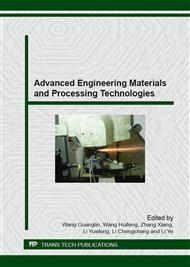p.162
p.168
p.173
p.181
p.187
p.194
p.200
p.206
p.213
Heat Transfer Analysis on Aluminum-Polymer Composite Molding Process
Abstract:
Aluminum-polymer composite products have advantages of metals with high specific stiffness, specific strength and abrasion resistance as well as that of the polymers with easy forming and low cost. The aluminum-polymer parts with lightweight, high strength can be produced to meet the requirement and demand of market. The interface conditions between aluminum and polymer, especially the metal surface temperature has important effect on the strength of the molded products. On the basis of aluminum-polymer composite molding principle, the heat transfer process during the molding process is analyzed. First, the finite element model for the aluminum and the metal mold heat transfer is established, and the boundary conditions are analyzed and calculated. Then the temperature field of the aluminum and the metal mold after heating process are obtained by finite element method. Lastly, the simulation results are compared with the actual temperature test. It is showed that the simulation and test results are in good condition within error range. Results presented in this paper can be helpful to study the mechanism of aluminum-polymer composite molding process and improve their interface strength.
Info:
Periodical:
Pages:
187-193
Citation:
Online since:
October 2015
Authors:
Price:
Сopyright:
© 2016 Trans Tech Publications Ltd. All Rights Reserved
Share:
Citation:


